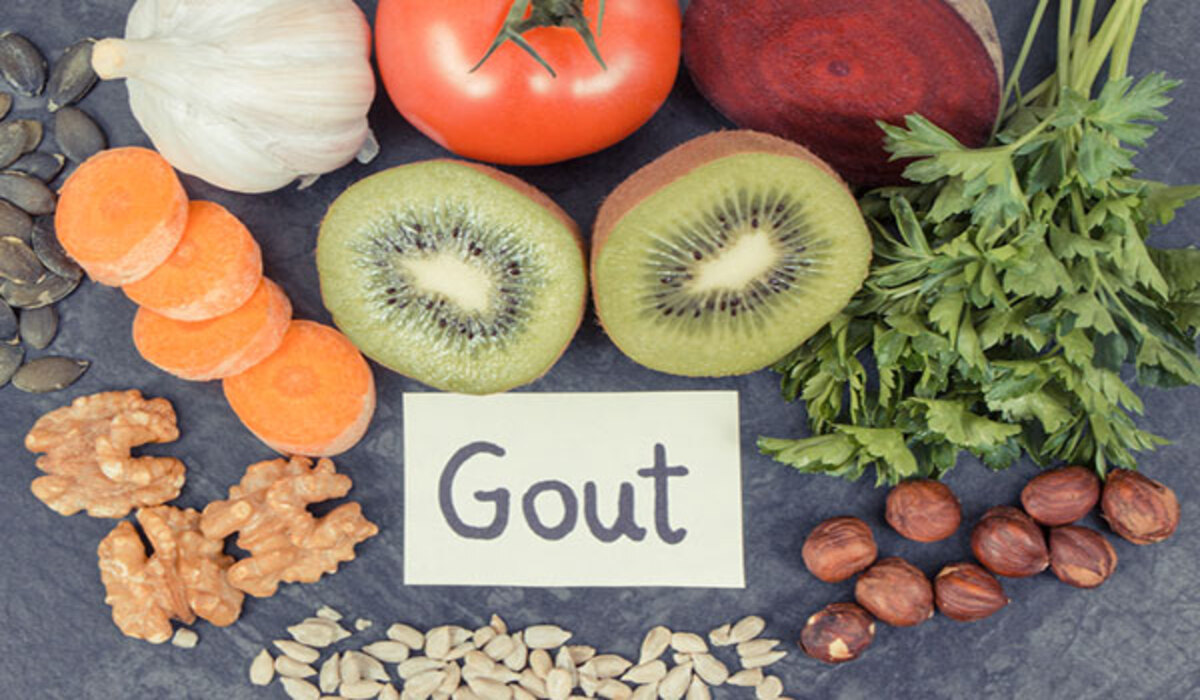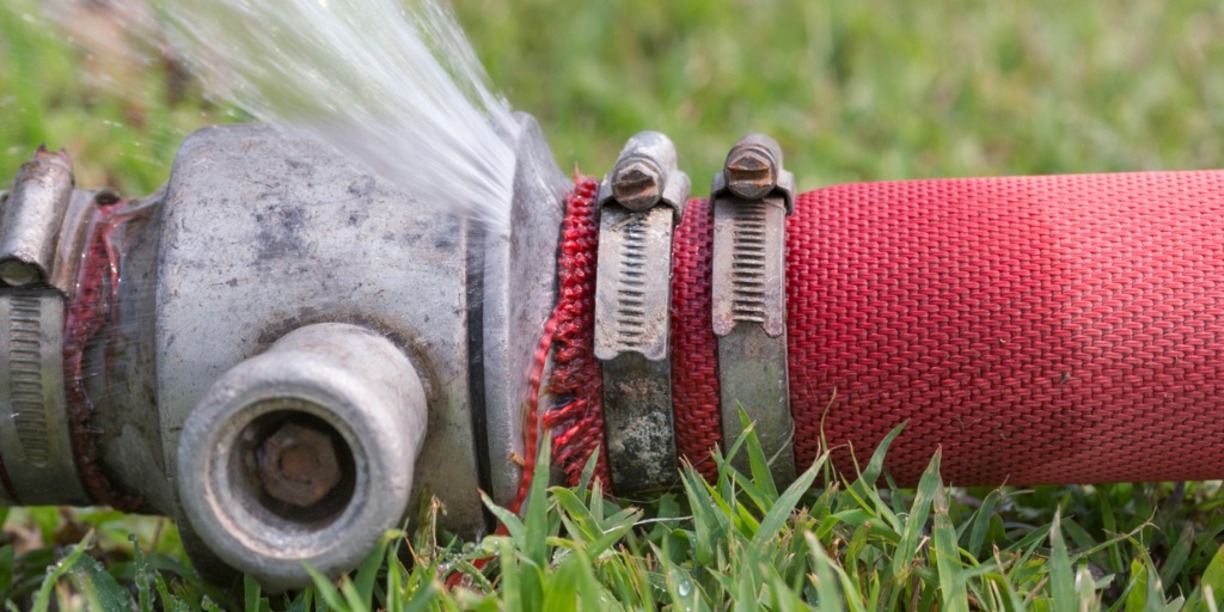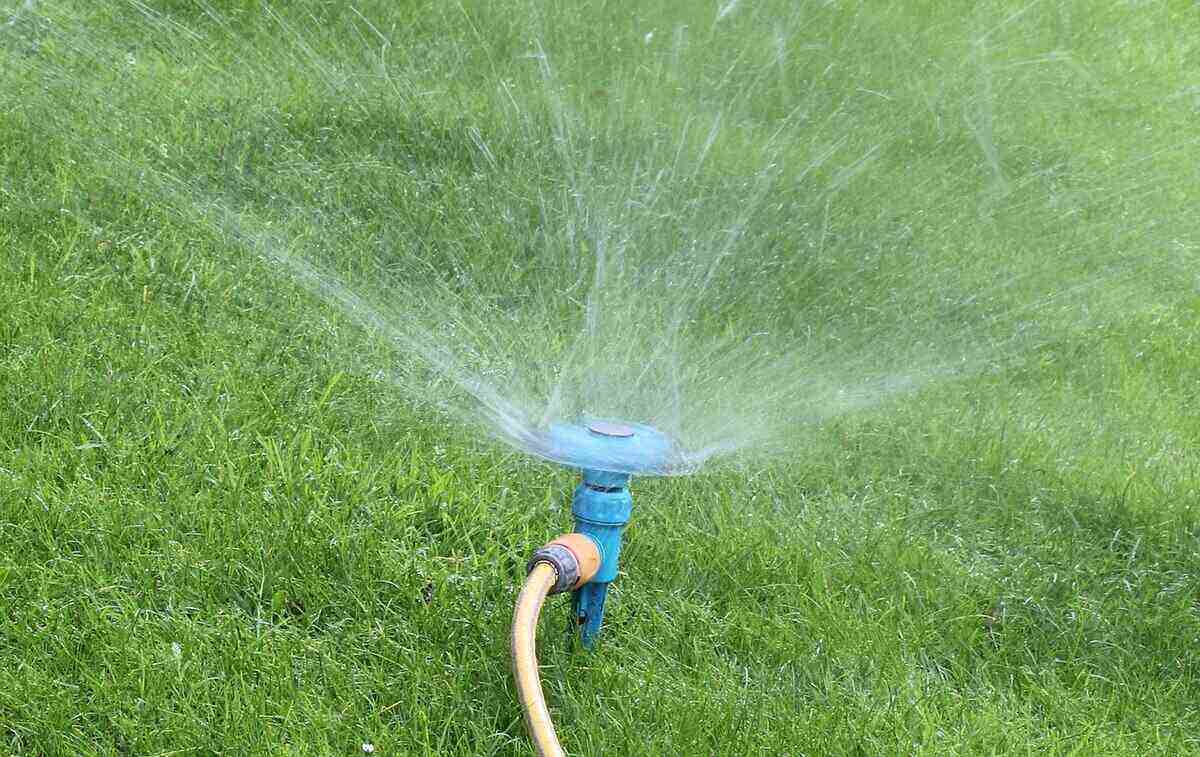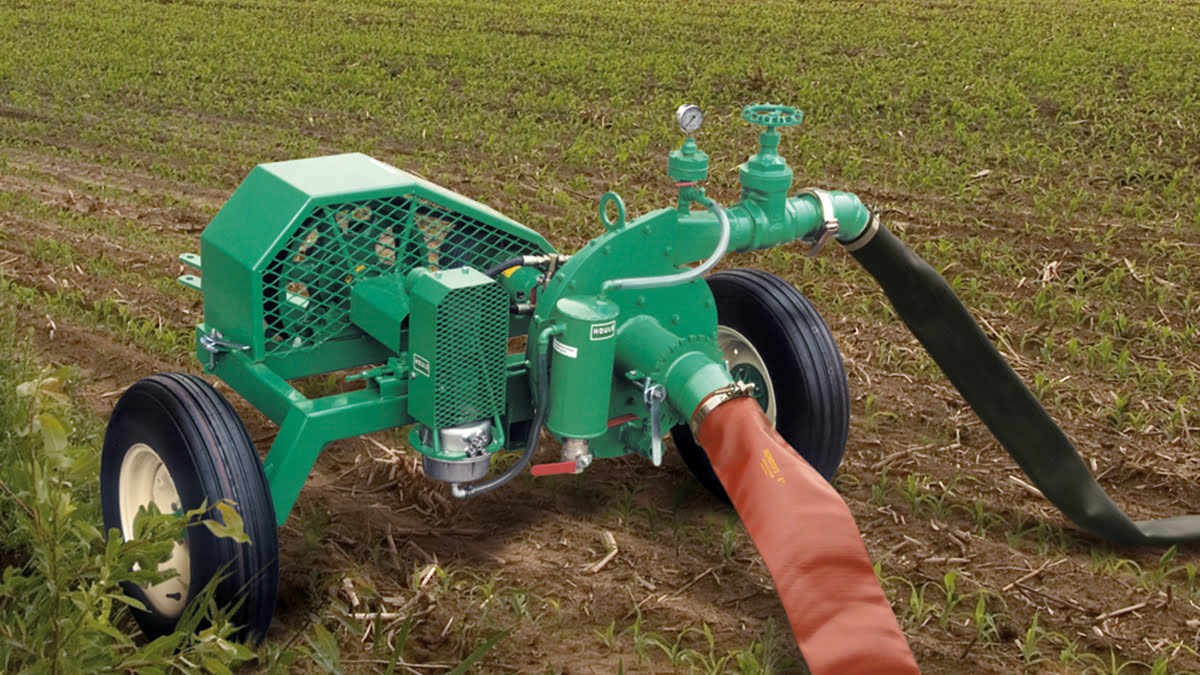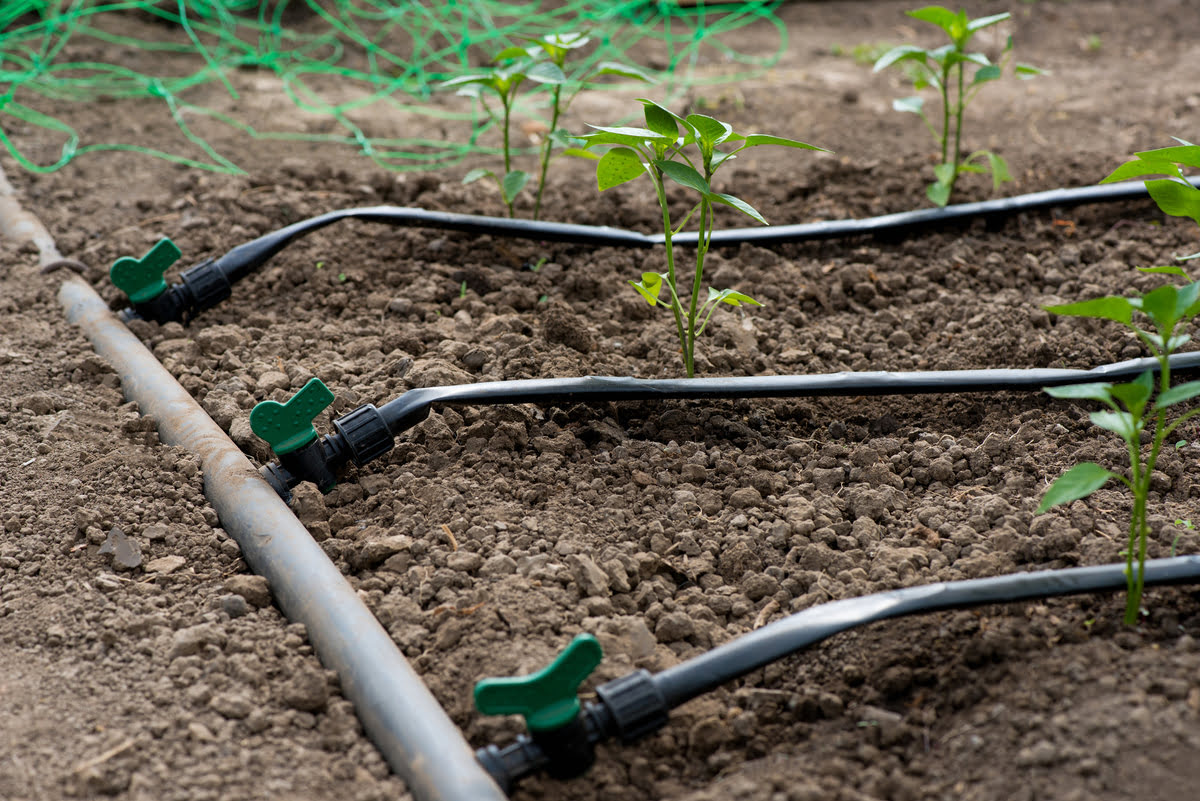Home>Gardening News and Trends>Latest News>Why Is Irrigation Bad
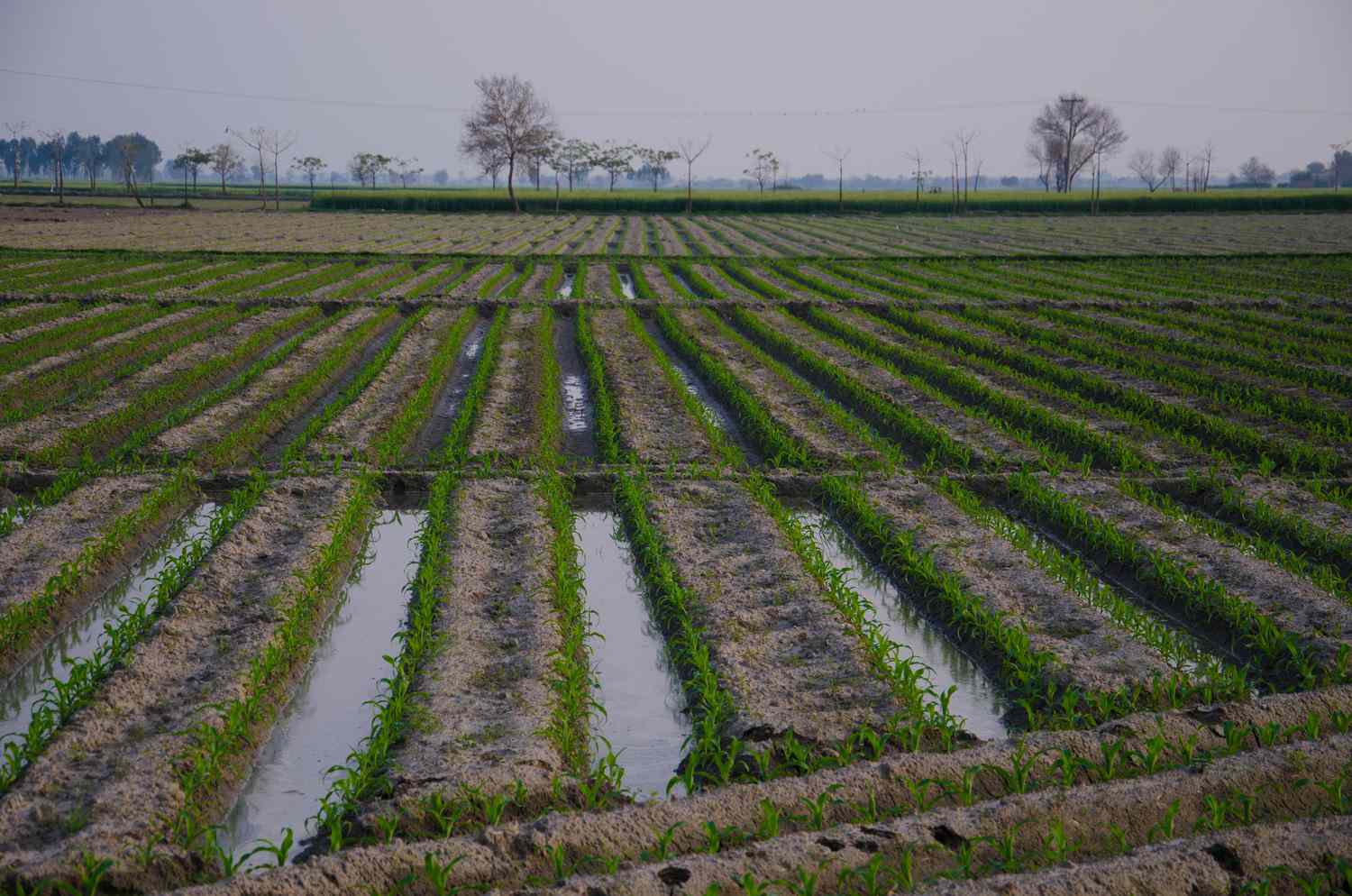

Latest News
Why Is Irrigation Bad
Modified: January 22, 2024
Stay updated with the latest news on why irrigation can be harmful to the environment and learn about the negative impacts it can have on ecosystems.
(Many of the links in this article redirect to a specific reviewed product. Your purchase of these products through affiliate links helps to generate commission for Chicagolandgardening.com, at no extra cost. Learn more)
Table of Contents
- Introduction
- The Environmental Impact of Irrigation
- Depletion of Water Resources
- Soil Degradation
- Water Pollution
- Disruption of Ecosystems
- Negative Effects on Biodiversity
- Health Risks Associated with Irrigation
- Increased Salinity in Soil
- Economic Drawbacks of Irrigation
- Cost of Infrastructure
- Energy Consumption
- Decreased Crop Diversity
- Conclusion
Introduction
Irrigation, the practice of supplying water to crops, is widely used around the world to increase agricultural productivity and ensure food security. While irrigation has played a significant role in transforming arid and semi-arid regions into fertile agricultural hubs, it is not without its drawbacks. The environmental impact of irrigation has become a cause for concern, prompting researchers and policymakers to rethink its widespread usage.
In this article, we will delve into the negative effects of irrigation on the environment, the depletion of water resources, soil degradation, water pollution, disruptions to ecosystems, and the decline of biodiversity. Additionally, we will explore the health risks associated with irrigation, the increased salinity in soil, and the economic drawbacks of this agricultural practice.
It is crucial to note that this article aims to shed light on the negative aspects of irrigation and does not discount its importance in sustaining global agriculture. The objective is to encourage thoughtful interventions and sustainable agricultural practices that minimize the adverse impact of irrigation on the environment while ensuring food security.
Now, let us delve into the various environmental, health, and economic ramifications of irrigation.
The Environmental Impact of Irrigation
Irrigation has a significant impact on the environment, affecting various aspects such as water resources, soil quality, ecosystems, and biodiversity. While it has undeniable benefits for agricultural productivity, the following negative consequences must be considered.
Depletion of Water Resources: One major concern associated with irrigation is the excessive use of water. As water is diverted from natural sources for irrigation, it often leads to a depletion of water resources. This results in reduced streamflow, lowered water tables, and the drying up of lakes and wetlands. In regions where water scarcity is already an issue, such as arid and semi-arid areas, increased irrigation can exacerbate the problem and lead to long-term ecological imbalances.
Soil Degradation: The constant application of water for irrigation can lead to soil degradation. Over time, excessive irrigation can cause soil erosion, waterlogging, and the buildup of salts in the soil. Waterlogged soil becomes deprived of oxygen, leading to the death of beneficial soil organisms and adversely impacting plant growth. Furthermore, the accumulation of salts in the soil can hinder plant nutrient uptake and ultimately reduce crop yields.
Water Pollution: The use of irrigation systems often involves the application of fertilizers and pesticides to enhance crop growth and control pests. However, these chemicals can leach into water bodies, contaminating both surface and groundwater. This pollution not only affects aquatic ecosystems but can also have detrimental effects on human health if contaminated water is consumed or used for irrigation of other crops.
Disruption of Ecosystems: Irrigation projects often require the construction of dams, canals, and reservoirs, resulting in the alteration or destruction of natural habitats. Such infrastructure development can lead to the displacement of wildlife, loss of biodiversity, and fragmentation of ecosystems. The loss of natural habitats and disruption of ecological processes can have far-reaching consequences on the overall balance of ecosystems.
Negative Effects on Biodiversity: The conversion of natural landscapes for irrigation purposes can result in the loss of biodiversity. Wetlands, forests, and grasslands are often transformed into agricultural fields, reducing the habitat available for a variety of plant and animal species. This loss of biodiversity can disrupt ecological interactions and have cascading effects throughout the food chain.
As we can see, irrigation has several detrimental effects on the environment. The next sections will explore the health risks associated with irrigation, the economic drawbacks, and possible solutions to mitigate these negative consequences.
Depletion of Water Resources
One of the most significant concerns arising from irrigation is the depletion of water resources. As water is diverted from natural sources, such as rivers, lakes, and groundwater, to satisfy the high demand for irrigation, water scarcity becomes a pressing issue.
Excessive irrigation can negatively impact water availability in multiple ways. First, the diversion of water from rivers and lakes diminishes the flow of these water bodies, affecting ecosystems that rely on them. Reduced streamflow can harm aquatic life and disrupt the delicate balance of ecosystems in riparian areas.
In addition, intensive irrigation can lead to the lowering of water tables. When farmers constantly extract large volumes of groundwater to meet irrigation needs, it reduces the natural recharge of aquifers. This not only threatens the sustainability of groundwater resources but also increases the risk of land subsidence and saltwater intrusion in coastal areas.
Moreover, the expansion of irrigation often results in the drying up of wetlands, which are crucial habitats for various plant and animal species. Wetlands play a vital role in water purification, flood control, and supporting biodiversity. Their loss due to irrigation can have far-reaching ecological consequences.
Climate change exacerbates the problem of water depletion in areas dependent on irrigation. As temperatures rise and weather patterns become more unpredictable, water availability becomes even more uncertain. Extended periods of drought and reduced rainfall further strain water resources, challenging the sustainability of irrigation practices.
Solutions to address the depletion of water resources associated with irrigation include implementing water-saving techniques and adopting more efficient irrigation methods. Drip irrigation, for example, applies water directly to the plant’s root zone, reducing water loss through evaporation and improving water-use efficiency. The use of precision irrigation technologies that monitor soil moisture levels can also help optimize water usage.
Furthermore, encouraging farmers to practice crop rotation and diversify their agricultural practices can reduce the reliance on irrigation and promote more sustainable water management. The integration of agroforestry and conservation agriculture techniques can improve soil water retention capacity and minimize irrigation requirements.
Policy interventions are crucial in mitigating the depletion of water resources caused by irrigation. Implementing water pricing mechanisms, water rights systems, and regulations that promote sustainable irrigation practices can incentivize water conservation and responsible use. Collaboration among stakeholders, including farmers, communities, and government bodies, is essential to ensure the equitable distribution of water resources and the long-term sustainability of agriculture.
By addressing the issue of water depletion associated with irrigation, we can work towards sustainable water management and secure water resources for future generations.
Soil Degradation
Irrigation, while essential for crop growth, can have detrimental effects on soil quality and lead to soil degradation over time. The continuous application of water for irrigation can cause various issues that negatively impact soil health and agricultural productivity.
One major consequence of excessive irrigation is soil erosion. When water is applied too quickly or in large quantities, it can lead to the displacement of soil particles, resulting in the loss of topsoil. This erosion not only depletes the nutrient-rich layer but also reduces the soil’s ability to retain water, leading to increased runoff and decreased water infiltration.
Waterlogging is another prevalent issue associated with irrigation. When the soil becomes saturated with water due to excessive irrigation, it hinders oxygen availability to plant roots. Oxygen is essential for root development and nutrient uptake, so waterlogged soil can severely impact plant growth and overall crop productivity.
Furthermore, the excessive application of water for irrigation can cause the accumulation of salts in the soil, a process known as salinization. As water evaporates from the soil surface, it leaves behind salts that are naturally present or introduced through fertilizers. Over time, the salt concentration rises to levels that are detrimental to plant growth. Salinized soil becomes less fertile, hindering seed germination, root development, and nutrient absorption by plants.
Another consequence of irrigation-induced soil degradation is the loss of soil organic matter. The constant application of water can accelerate the decomposition of organic matter, reducing the soil’s ability to retain nutrients and moisture. This loss of organic matter in the soil compromises its structure, nutrient-holding capacity, and overall fertility.
To combat soil degradation caused by irrigation, several strategies can be implemented. One approach is the adoption of conservation tillage practices, such as no-till or reduced tillage. These practices minimize soil disturbance, reduce erosion, and enhance soil moisture retention.
Another effective technique is the implementation of proper drainage systems to mitigate waterlogging. Installing subsurface drainage can help remove excess water from the root zone, ensuring adequate oxygen supply and improving soil aeration.
To prevent salinization, practices such as leaching and controlled drainage can be employed. Leaching involves flushing excess salts from the soil through the application of additional water, while controlled drainage helps maintain optimum water tables to reduce salt accumulation.
Incorporating organic matter through the use of cover crops, crop residues, or compost can improve soil structure and enhance nutrient availability. Organic matter acts as a sponge, increasing water-holding capacity and minimizing the risk of soil erosion.
Educating farmers about proper irrigation scheduling and water management techniques is vital to prevent over-irrigation and the associated soil degradation. By monitoring soil moisture levels, farmers can ensure that water is applied only when necessary, reducing the risk of waterlogging and excessive salt buildup.
Implementing sustainable irrigation practices, such as deficit irrigation or regulated deficit irrigation, can also help minimize the negative impact on soil health. These practices involve applying water at specific growth stages or allowing mild water stress to increase water-use efficiency and reduce the risk of soil degradation.
By adopting these strategies and promoting sustainable soil management practices, we can mitigate soil degradation caused by irrigation and ensure the long-term productivity and resilience of agricultural lands.
Water Pollution
Water pollution is a significant concern associated with irrigation practices. The use of fertilizers, pesticides, and other agricultural chemicals in irrigation can lead to the contamination of water sources, both surface and groundwater. This pollution has detrimental effects on aquatic ecosystems and poses risks to human health.
The application of fertilizers in irrigated fields aims to provide essential nutrients to crops for optimal growth. However, these fertilizers can be washed off from fields through irrigation runoff or leach into groundwater, causing nutrient pollution in water bodies. Excessive nitrogen and phosphorus from fertilizers can lead to eutrophication, a process in which water bodies become enriched with nutrients, triggering excessive algae and plant growth. This can create algal blooms, deplete oxygen levels, and ultimately harm aquatic organisms.
In addition to nutrient pollution, the use of pesticides and herbicides for pest control in irrigated agriculture can have harmful effects on aquatic life. These chemical compounds can enter water bodies through irrigation runoff or infiltration, contaminating freshwater ecosystems. Pesticides can be toxic to aquatic organisms, including fish, amphibians, and invertebrates, disrupting their reproductive systems and overall health.
Furthermore, the presence of agricultural chemicals, including fertilizers and pesticides, in water sources can pose risks to human health. If contaminated water is consumed or used for irrigation of other crops, these chemicals can enter the food chain. Prolonged exposure to pesticide-contaminated water or food can have adverse health effects, including developmental issues, hormone disruption, and increased cancer risk.
Preventing water pollution from irrigation requires adopting best management practices and implementing regulations. Integrated Pest Management (IPM) techniques can help minimize the use of pesticides, employing alternative pest control methods, such as biological control or crop rotation. Precision application methods, such as localized irrigation or using sprinkler systems with smart controllers, can reduce the likelihood of excessive fertilizers or chemical runoff.
Buffer zones, such as vegetative strips or wetlands, can be implemented along water bodies to capture and filter runoff, reducing the transport of pollutants into aquatic ecosystems. Constructed wetlands can also be utilized to treat agricultural runoff, removing excess nutrients and pesticides before they enter water bodies.
Effective monitoring and enforcement of water quality standards are essential to identify and address instances of water pollution. Regular testing of water sources and strict regulations on the use and application of agricultural chemicals can help mitigate water pollution risks associated with irrigation.
Improving farmer education and promoting awareness about the potential impacts of agricultural chemicals on water quality is crucial. By providing training on proper handling, application, and disposal of agricultural chemicals, farmers can minimize the risk of water contamination.
Through a combination of sound agricultural practices, effective regulations, and awareness-raising efforts, we can address water pollution associated with irrigation and safeguard both aquatic ecosystems and human health.
Disruption of Ecosystems
Irrigation projects often involve the construction of dams, canals, and reservoirs, resulting in the disruption and alteration of natural habitats. These modifications to the landscape can have significant impacts on ecosystems, leading to the displacement of wildlife, loss of biodiversity, and fragmentation of habitats.
One of the immediate consequences of irrigation-related ecosystem disruption is the alteration of natural water flow patterns. Dams and reservoirs modify the natural flow of rivers, which can negatively affect aquatic species that depend on specific flow patterns for migration, breeding, and feeding. Additionally, the construction of canals can fragment river and wetland habitats, limiting the movement of aquatic species and disrupting their ecological processes.
The conversion of natural landscapes into agricultural fields for irrigation purposes often results in the loss of native vegetation cover. Forests, wetlands, and grasslands are cleared to make way for irrigation infrastructure and croplands, leading to habitat destruction. This destruction directly affects biodiversity, as many plant and animal species rely on these habitats for survival, nesting, and foraging.
Disrupted habitats also impact the intricate relationships between species. When ecosystems are fragmented, it becomes challenging for species to move between habitats and find appropriate resources, such as food and mates. This disruption can lead to declines in populations and even the local extinction of species, upsetting the delicate ecological balance.
Moreover, irrigation can cause changes in the water table and hydrological patterns, further impacting surrounding ecosystems. The altered water levels can lead to changes in soil moisture, affecting the type of vegetation that can grow in a specific area. This, in turn, affects the food sources and habitats of various wildlife species, disrupting their natural dynamics.
Efforts to mitigate the disruption of ecosystems caused by irrigation include implementing measures that prioritize ecological connectivity. Creating wildlife corridors, greenways, and protected areas can help facilitate species movement and maintain their access to different habitats. These measures can promote gene flow, enhance species resilience, and contribute to the overall biodiversity conservation.
Furthermore, embracing sustainable agricultural practices within irrigated areas can help minimize the overall impact on ecosystems. By promoting agroforestry, crop diversity, and the restoration of natural habitats within agricultural lands, it is possible to create a more harmonious coexistence between agriculture and ecosystems.
Collaborative efforts among stakeholders, including farmers, conservation organizations, and policymakers, are essential to address the disruption of ecosystems caused by irrigation. Implementing comprehensive environmental impact assessments prior to irrigation projects can help identify potential risks and design mitigation strategies accordingly. Engaging local communities and indigenous people in decision-making processes can also contribute to more environmentally sensitive and sustainable irrigation practices.
By recognizing and mitigating the disruption of ecosystems caused by irrigation, we can strive for a more balanced approach that supports both agricultural productivity and the preservation of biodiversity.
Negative Effects on Biodiversity
The expansion of irrigation and the conversion of natural landscapes into agricultural fields have significant negative impacts on biodiversity. These changes in land use lead to the loss of natural habitats, resulting in a decline in biodiversity and ecological imbalances.
One of the primary effects of irrigation on biodiversity is the loss of native vegetation cover. Forests, wetlands, and grasslands are often cleared or modified to make way for agricultural fields, irrigation infrastructure, and drainage systems. This loss of natural habitats directly affects a wide range of plant and animal species that rely on these habitats for essential functions such as nesting, foraging, and reproduction.
The decline in habitat availability caused by irrigation can lead to the local extinction or reduction of certain species. As their natural habitats are cleared or fragmented, species may struggle to find suitable areas to establish their populations. Increased habitat fragmentation can isolate populations, making them vulnerable to genetic bottlenecks, inbreeding, and reduced resilience to environmental changes.
In addition to habitat loss and fragmentation, irrigation can also disrupt ecological interactions and food chains. As irrigation alters water availability and hydrological patterns, it can affect the distribution and abundance of species that depend on specific water sources or aquatic ecosystems for survival. Changes in water levels and flow can impact the availability of prey or affect the reproduction of aquatic organisms, cascading down the food chain and impacting species at various trophic levels.
Biodiversity loss due to irrigation extends beyond plants and animals. It also affects microbial communities, which play vital roles in soil fertility, nutrient cycling, and ecosystem functioning. The alteration of irrigation practices can disrupt these microbial communities, affecting the overall health and resilience of agroecosystems.
Furthermore, the conversion of natural habitats for irrigated agriculture can introduce non-native species and increase the risk of biological invasions. New agricultural landscapes often create favorable conditions for certain invasive species to thrive, outcompeting native species for resources and further eroding biodiversity.
Protecting and restoring biodiversity within irrigated areas can help mitigate the negative effects of irrigation on biodiversity. Implementing agroecological practices, such as polyculture, crop rotation, and the restoration of natural habitats within agricultural fields, can support biodiversity and provide habitat corridors for species movement.
Conservation strategies such as the establishment of protected areas, wildlife corridors, and ecologically sensitive zones can help maintain connectivity between different habitats and promote species movement across the landscape. Integrating these conservation measures into irrigation planning and management is crucial for safeguarding biodiversity.
Collaboration among farmers, researchers, conservation organizations, and policymakers is vital in developing and implementing biodiversity conservation plans. By considering biodiversity in irrigation system design and management, we can seek to minimize the negative impacts on species and ecosystems, thereby promoting sustainable agricultural practices that coexist with biodiversity.
Health Risks Associated with Irrigation
While irrigation plays a crucial role in ensuring food security, it also presents potential health risks to both agricultural workers and the general population. These risks are primarily associated with exposure to agricultural chemicals, waterborne diseases, and increased salinity in soil.
One significant health risk related to irrigation is the exposure to agricultural chemicals used in crop production. Pesticides and herbicides applied to irrigated fields can contaminate water sources, leading to the potential for human exposure. Agricultural workers who handle and apply these chemicals without proper protective measures are particularly vulnerable to health risks such as skin irritation, respiratory problems, and even long-term health implications such as cancer or reproductive disorders.
Waterborne diseases are another concern associated with irrigation. When water sources used for irrigation are contaminated with fecal matter or pathogenic microorganisms, there is an increased risk of waterborne diseases spreading through consumption of contaminated crops or direct contact with contaminated water. Examples of such diseases include diarrhea, cholera, typhoid fever, and parasitic infections like cryptosporidiosis and giardiasis.
Furthermore, the excessive salinity that can result from irrigation practices poses health risks. When soils become highly saline due to the accumulation of salts from irrigation water, it can affect the growth and quality of crops. Additionally, consuming crops that have been irrigated with highly saline water can have detrimental effects on human health, as excessive salt intake can contribute to conditions like high blood pressure and cardiovascular diseases.
Protecting human health in the context of irrigation involves implementing measures to minimize exposure to agricultural chemicals and ensuring the quality and safety of irrigation water. Proper training and education for farmers on the correct handling, application, and storage of pesticides can help reduce their potential health risks. The use of integrated pest management practices, which focus on the use of biological controls and selective pesticide application, can also mitigate the need for excessive chemical use.
Regarding waterborne diseases, implementing proper water management and treatment systems is crucial. Safe irrigation water sources, regular monitoring of water quality, and effective treatment methods such as filtration or chlorination can help reduce the risk of waterborne diseases associated with irrigation. Promoting hygiene and sanitation practices, both among agricultural workers and the general population, further reduces the potential exposure to waterborne pathogens.
Addressing the issue of increased salinity in soil requires careful water management and salt leaching practices. Measures such as improving drainage systems, using high-quality irrigation water, and implementing appropriate irrigation scheduling can help prevent the accumulation of salts in the soil. Additionally, selecting salt-tolerant or salt-resistant crop varieties can mitigate the impacts of salinity on crop yield and quality.
Government regulations and policies that promote safe agricultural practices, establish water quality standards, and provide guidelines for pesticide use are essential in safeguarding human health. Public awareness and education on the potential health risks associated with irrigation, along with implementing best practices and sustainable agriculture techniques, contribute to a healthier and safer agricultural environment.
Increased Salinity in Soil
One of the significant challenges arising from irrigation is the increased salinity in soil. When water is used for irrigation, especially in arid and semi-arid regions, the evaporative loss of water leaves behind salts, resulting in the accumulation of salts in the soil over time. This process, known as salinization, can have detrimental effects on plant growth, soil fertility, and agricultural productivity.
Salinity poses a threat to agriculture as excessive salt concentrations in the soil can hinder the growth and development of plants. When soils become highly saline, it can impede the uptake of water and essential nutrients by plant roots. The high salt content causes water to move out of the root zone through osmosis, leading to water stress and dehydration in plants. This affects their ability to absorb water and nutrients, resulting in reduced crop yields and poor quality produce.
Moreover, the presence of high salt levels in the soil alters the physical properties of the soil, affecting its structure and permeability. Saline soils have poor soil structure, with reduced water-holding capacity and increased susceptibility to erosion. The crusting of saline soils can hinder seedling emergence, limit root penetration, and impede gas exchange, further impeding plant growth.
Excessive soil salinity can also affect soil microbial communities, disrupting their activities and nutrient cycling processes. Saline conditions can inhibit the growth and diversity of beneficial soil organisms, impacting soil fertility and the overall health of the agroecosystem.
To mitigate the negative effects of increased salinity in soil, several strategies can be employed. Implementing proper irrigation methods, such as drip irrigation or sprinkler systems, can prevent excessive water application and reduce the risk of salt accumulation. By applying water directly to the root zone, these methods minimize evaporative losses and promote more efficient water use.
Applying irrigation water in a controlled manner, known as regulated deficit irrigation, can also help mitigate salinization. This approach involves providing plants with less water than they require during certain stages of the growth cycle, allowing salts to be leached from the root zone through a more concentrated solution.
Improving drainage systems is essential to combat soil salinity. Installing subsurface drainage systems, vertical drains, or tile drains helps remove excess water from the soil and prevent the upward movement of salts. Additionally, developing good land grading practices can ensure proper water movement and prevent waterlogging, which can contribute to salt accumulation.
The use of salt-tolerant crops and crop varieties can also be beneficial in managing soil salinity. These plants can withstand conditions of higher salt concentrations, enabling agricultural productivity in saline environments. Additionally, integrating salt-tolerant cover crops or halophytes (salt-loving plants) into the rotation can help improve soil structure, reduce salt buildup, and enhance soil fertility.
By applying these strategies and employing sustainable agricultural practices, it is possible to mitigate the adverse effects of increased soil salinity. Regular monitoring of soil salinity levels, implementing appropriate irrigation and drainage techniques, and promoting soil management practices that minimize salt accumulation are key to maintaining soil health and agricultural sustainability.
Economic Drawbacks of Irrigation
While irrigation is crucial for agricultural production and food security, it also presents various economic drawbacks. These challenges stem from the costs associated with irrigation infrastructure, increased energy consumption, and the potential impact on crop diversity.
One of the primary economic drawbacks of irrigation is the cost of infrastructure development. Constructing irrigation systems, including dams, canals, and reservoirs, requires significant investment in terms of capital, materials, and labor. The costs of land acquisition, engineering, and maintenance further contribute to the financial burden. These high initial investment costs can be a barrier, particularly for small-scale farmers who may struggle to afford the necessary infrastructure.
Maintaining irrigation infrastructure also incurs ongoing operational costs. Regular maintenance, repairs, and the management of irrigation networks require financial resources that must be factored into the overall cost of irrigation. Additionally, the expenses of water supply and distribution systems, such as pumping stations, can significantly increase the economic burden, impacting farm profitability.
Another economic drawback is the increased energy consumption associated with irrigation. In many cases, irrigation systems rely on pumping water from natural sources, necessitating the use of energy sources such as electricity or fossil fuels. The demand for energy to power irrigation systems and sustain water supply can place a financial strain on farmers, particularly when energy prices are high. This increased energy consumption also has environmental implications, as it contributes to greenhouse gas emissions and exacerbates climate change.
Furthermore, the expansion of irrigated agriculture can result in a decrease in crop diversity and an overreliance on certain staple crops. Large-scale irrigation projects often focus on crops that provide high yields and have market demand. This can lead to a reduction in the cultivation of traditional and local crop varieties, potentially diminishing agricultural biodiversity. In turn, the dependence on a limited range of crops can increase vulnerability to pests, diseases, and market fluctuations, posing economic risks to farmers.
Despite these economic drawbacks, there are opportunities for mitigating the costs and limitations associated with irrigation. Investing in research and technological advancements that improve water efficiency in irrigation systems can help reduce costs by optimizing water usage. This includes the use of precision irrigation techniques, remote sensing technology, and water management tools that enhance water productivity and reduce wastage.
Exploring alternative sources of energy, such as renewable energy options, for powering irrigation systems can help reduce energy costs and minimize the environmental impact. Government incentives and support programs targeting farmers can facilitate the adoption of energy-efficient practices, such as solar-powered irrigation systems or utilizing biofuels for pumps.
Supporting and promoting crop diversification within irrigated areas can help mitigate economic risks. This can be achieved through the development of markets and value chains for a wider range of crops, providing farmers with incentives to diversify their agricultural production. By diversifying crops, farmers can reduce economic vulnerability and improve resilience to changing market conditions.
Furthermore, policymakers can implement financial support mechanisms, such as subsidies and loans, to assist farmers in affording the initial costs of irrigation infrastructure and ongoing maintenance. Providing access to affordable credit and innovative financing options can help alleviate the economic burden associated with irrigation, particularly for small-scale farmers.
By addressing the economic challenges and finding ways to enhance the efficiency and affordability of irrigation systems, we can ensure the economic viability of irrigated agriculture while maximizing its benefits for food production and rural development.
Cost of Infrastructure
One of the significant economic drawbacks of irrigation is the high cost associated with the development and maintenance of infrastructure. The construction of irrigation systems, including dams, canals, reservoirs, and pumping stations, requires substantial financial investment.
The cost of infrastructure for irrigation can be significant due to various factors. Firstly, the acquisition of land for the development of irrigation projects can be a substantial expense. Large areas of land need to be acquired to accommodate canals, reservoirs, and other infrastructure components. Land acquisition costs can vary significantly depending on the location, land values, and availability of suitable sites, adding to the overall expense of irrigation projects.
Engineering and construction costs constitute another significant component of the infrastructure expenses. Building structures like dams and reservoirs, excavating canals, and installing irrigation networks require specialized expertise and materials. The complexity and scale of these projects can contribute to higher construction costs, especially in challenging terrains or regions with adverse geological conditions.
Maintenance and operational costs are ongoing expenses associated with irrigation infrastructure. Regular maintenance activities, such as clearing canals, repairing structures, and maintaining pump stations, require financial resources to ensure the longevity and functionality of the system. Adequate funding for operations and maintenance is crucial to prevent the deterioration of infrastructure and to ensure the continuous supply of water for irrigation purposes.
These costs can pose significant challenges, particularly for small-scale farmers or resource-constrained regions. The high initial investment and ongoing operational costs may limit the accessibility of irrigation infrastructure to farmers who cannot afford the expenses. This can lead to disparities in access to irrigation, potentially exacerbating existing inequalities in agricultural productivity and income.
However, there are strategies to address the high cost of irrigation infrastructure. Government support and public-private partnerships can play a crucial role in providing financial assistance and facilitating the development of irrigation projects. By sharing the financial burden and leveraging resources, the cost of infrastructure can be more manageable for farmers and local communities.
International organizations and development agencies can also provide funding and technical support for irrigation projects, particularly in regions that face water scarcity or where irrigation is crucial for enhancing agricultural productivity and food security. These collaborations can help mobilize resources and expertise to ensure cost-effective and sustainable infrastructure development.
Moreover, embracing innovative approaches to irrigation infrastructure can help lower costs. The integration of technology, such as remote sensing, precision irrigation, and automation, can enhance the efficiency of irrigation systems and reduce resource wastage. Implementing water-saving techniques, such as drip irrigation or micro-sprinklers, can optimize water use and minimize the need for extensive infrastructure.
Effective planning and project management are vital to control infrastructure costs. Conducting thorough feasibility studies, considering alternative options, and adopting cost-saving measures during the design and construction phases can help optimize investments and reduce unnecessary expenses. Regular monitoring and evaluation of irrigation projects can also identify potential issues early on and allow for timely corrective measures.
By addressing the cost of infrastructure through strategic partnerships, innovative approaches, and careful planning, it is possible to make irrigation more accessible and financially viable for farmers, while also maximizing the benefits of irrigation for agricultural productivity and rural development.
Energy Consumption
Energy consumption is a significant economic drawback associated with irrigation. Irrigation systems often require substantial amounts of energy to operate, which can result in increased costs for farmers and environmental implications due to greenhouse gas emissions.
The pumping of water is a primary contributor to energy consumption in irrigation. Water needs to be moved from its source, such as rivers, reservoirs, or groundwater, to the fields. This requires the use of pumps, which may be powered by electricity, diesel, or other energy sources. The energy-intensive process of lifting and distributing water to irrigated areas increases the overall energy demand of irrigation systems.
The reliance on non-renewable energy sources, such as fossil fuels, for powering irrigation systems further exacerbates the environmental impact. The combustion of fossil fuels releases greenhouse gases, contributing to climate change and environmental degradation. This reliance on non-renewable energy sources also exposes farmers to the volatility of energy prices, which can fluctuate and add financial uncertainty to irrigation operations.
Efforts to reduce energy consumption associated with irrigation systems can offer numerous benefits. One approach is promoting the use of renewable energy sources, such as solar power or wind energy, to meet the energy demands of irrigation systems. Solar-powered pumps, for example, can provide a sustainable and cost-effective alternative to traditional energy sources, reducing both energy costs and greenhouse gas emissions.
Improving the overall energy efficiency of irrigation systems is another crucial strategy. Upgrading and maintaining pumps and other irrigation equipment to ensure optimal performance can minimize energy losses and reduce the energy required to move water. Implementing advanced technologies, like variable frequency drives and energy management systems, can help optimize energy consumption by adjusting pump speed and controlling water flow according to crop needs.
Adopting water-saving irrigation techniques can also contribute to energy conservation. Precision irrigation methods, such as drip irrigation and micro-sprinklers, deliver water directly to plants, minimizing evaporation and water loss compared to traditional flood irrigation. By using water more efficiently, farmers can reduce the amount of energy needed to deliver water to the fields.
Education and awareness campaigns can play a crucial role in encouraging energy-efficient practices among farmers. Providing technical training on irrigation system design, maintenance, and energy management empowers farmers to make informed decisions regarding energy consumption. Financial incentives and support systems, such as grants or loans, can also encourage farmers to invest in energy-efficient irrigation technologies.
Policy-level interventions, such as the implementation of energy pricing mechanisms or subsidies for renewable energy systems, can play a significant role in promoting sustainable energy use in agriculture. Governments can provide financial incentives to farmers who adopt renewable energy technologies, which can help offset the initial investment costs and spur the transition to more sustainable irrigation practices.
By reducing energy consumption through the adoption of renewable energy sources, enhancing system efficiency, and implementing water-saving techniques, the economic and environmental burdens associated with energy use in irrigation can be mitigated. Striving for energy-efficient irrigation systems not only benefits farmers by reducing costs but also contributes to the global goals of environmental sustainability and climate change mitigation.
Decreased Crop Diversity
One of the economic drawbacks of irrigation is the potential decrease in crop diversity. When agricultural lands are converted for irrigation purposes, there can be a shift towards the cultivation of a limited range of high-yielding crop varieties, leading to a reduction in crop diversity.
Irrigation projects often focus on crops that have high market demand, high productivity, and are economically lucrative for farmers. These crops are typically selected based on their ability to generate high yields and adaptability to irrigation conditions. As a result, there is a tendency to favor a few major crops, such as wheat, rice, and maize, while neglecting other traditional or local crop varieties.
Decreased crop diversity poses several challenges. Firstly, it reduces the availability of a wide range of food crops, limiting dietary choices and potentially leading to a less nutritious and balanced diet for local populations. Reduced access to a diverse range of crops can also hinder food security and resilience to external shocks, such as changes in market conditions or climate-related impacts.
Furthermore, the over-reliance on a few crop varieties can increase vulnerability to pests, diseases, and environmental changes. When a large portion of agricultural land is dedicated to a single crop, it creates a conducive environment for pests and diseases to thrive. Outbreaks of pests or diseases can quickly spread and devastate entire crops, leading to significant economic losses for farmers who have invested in these monocultures.
Additionally, a decrease in crop diversity can negatively impact ecosystem services. Different plant species provide habitat and food sources for various beneficial insects, pollinators, and other wildlife. Monocultures offer a limited range of resources, reducing biodiversity and disrupting ecological interactions. This disruption can have cascading effects on the overall functioning of agroecosystems, affecting soil health, nutrient cycling, and natural pest control mechanisms.
Promoting crop diversity within irrigated systems is crucial for mitigating these challenges. Encouraging the cultivation of a wide range of crops, including traditional, indigenous, and locally adapted varieties, can enhance biodiversity and increase the resilience of agroecosystems. Crop diversification can also lead to more sustainable land management practices, such as reduced need for chemical inputs, improved soil fertility, and more efficient water use.
Market incentives and value chain development can play a significant role in promoting crop diversity. Supporting local markets, farmers’ markets, and initiatives that connect consumers with a diverse array of crops can create demand and market opportunities for a wider range of crops. This can provide economic incentives for farmers to cultivate and preserve traditional and neglected crops.
Educating farmers about the benefits of crop diversification and providing technical assistance can help overcome barriers to adopting diversified farming systems. Sharing knowledge about agroecology, multi-cropping, and crop rotation practices can empower farmers to incorporate diverse crops into their irrigation systems and improve the overall sustainability of their agricultural practices.
Government policies and programs that offer incentives for crop diversification can also contribute to a more varied agricultural landscape. Providing financial support, access to seeds, and technical assistance for farmers interested in diversifying their crops can encourage the adoption of more diverse agricultural systems.
By prioritizing crop diversity within irrigated agriculture, we can enhance food security, promote sustainable agroecosystems, and increase the resilience of agricultural communities to environmental and economic risks.
Conclusion
Irrigation is a critical practice in agriculture that has contributed to increased food production and improved livelihoods. However, it is important to recognize and address the associated environmental, health, and economic drawbacks to ensure sustainable and responsible irrigation practices.
The environmental impact of irrigation includes water resource depletion, soil degradation, water pollution, disruption of ecosystems, and loss of biodiversity. These issues highlight the need for water conservation, proper soil management, and strategies to minimize chemical inputs, protect natural habitats, and promote biodiversity conservation.
Health risks associated with irrigation, such as exposure to agricultural chemicals, waterborne diseases, and increased soil salinity, necessitate the adoption of safe and sustainable irrigation practices. Proper handling and application of agricultural chemicals, the implementation of water treatment systems, and the promotion of good hygiene practices are essential to protect both farmers and consumers.
Economic drawbacks, such as the cost of infrastructure and increased energy consumption, can be addressed by implementing innovative technologies, utilizing renewable energy sources, and adopting water-efficient practices. Supporting diverse crop cultivation and promoting market opportunities for a wider range of crops can mitigate economic risks and enhance food security.
In conclusion, by recognizing and proactively addressing the negative consequences of irrigation, we can develop and promote sustainable practices that balance the need for increased agricultural productivity with environmental protection, human health, and economic viability. Collaboration among stakeholders, including farmers, researchers, policymakers, and communities, is crucial in ensuring the responsible use of irrigation and safeguarding the long-term sustainability of our agricultural systems.
